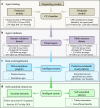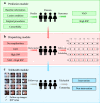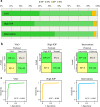Artificial intelligence manages congenital cataract with individualized prediction and telehealth computing
- PMID: 32904507
- PMCID: PMC7455726
- DOI: 10.1038/s41746-020-00319-x
Artificial intelligence manages congenital cataract with individualized prediction and telehealth computing
Abstract
A challenge of chronic diseases that remains to be solved is how to liberate patients and medical resources from the burdens of long-term monitoring and periodic visits. Precise management based on artificial intelligence (AI) holds great promise; however, a clinical application that fully integrates prediction and telehealth computing has not been achieved, and further efforts are required to validate its real-world benefits. Taking congenital cataract as a representative, we used Bayesian and deep-learning algorithms to create CC-Guardian, an AI agent that incorporates individualized prediction and scheduling, and intelligent telehealth follow-up computing. Our agent exhibits high sensitivity and specificity in both internal and multi-resource validation. We integrate our agent with a web-based smartphone app and prototype a prediction-telehealth cloud platform to support our intelligent follow-up system. We then conduct a retrospective self-controlled test validating that our system not only accurately detects and addresses complications at earlier stages, but also reduces the socioeconomic burdens compared to conventional methods. This study represents a pioneering step in applying AI to achieve real medical benefits and demonstrates a novel strategy for the effective management of chronic diseases.
Keywords: Computer science; Health care economics; Lens diseases; Translational research.
© The Author(s) 2020.
Conflict of interest statement
Competing interestsThe authors declare no competing interests.
Figures






Similar articles
-
A Hybrid Stacked CNN and Residual Feedback GMDH-LSTM Deep Learning Model for Stroke Prediction Applied on Mobile AI Smart Hospital Platform.Sensors (Basel). 2023 Mar 27;23(7):3500. doi: 10.3390/s23073500. Sensors (Basel). 2023. PMID: 37050561 Free PMC article.
-
Blockchain and K-Means Algorithm for Edge AI Computing.Comput Intell Neurosci. 2022 May 29;2022:1153208. doi: 10.1155/2022/1153208. eCollection 2022. Comput Intell Neurosci. 2022. Retraction in: Comput Intell Neurosci. 2023 Jul 26;2023:9867367. doi: 10.1155/2023/9867367. PMID: 35676965 Free PMC article. Retracted.
-
Universal artificial intelligence platform for collaborative management of cataracts.Br J Ophthalmol. 2019 Nov;103(11):1553-1560. doi: 10.1136/bjophthalmol-2019-314729. Epub 2019 Sep 2. Br J Ophthalmol. 2019. PMID: 31481392 Free PMC article.
-
Integrating Artificial and Human Intelligence: A Partnership for Responsible Innovation in Biomedical Engineering and Medicine.OMICS. 2020 May;24(5):247-263. doi: 10.1089/omi.2019.0038. Epub 2019 Jul 16. OMICS. 2020. PMID: 31313972 Review.
-
Artificial intelligence: A joint narrative on potential use in pediatric stem and immune cell therapies and regenerative medicine.Transfus Apher Sci. 2018 Jun;57(3):422-424. doi: 10.1016/j.transci.2018.05.004. Epub 2018 May 9. Transfus Apher Sci. 2018. PMID: 29784537 Review.
Cited by
-
Improving the Generalizability of Infantile Cataracts Detection via Deep Learning-Based Lens Partition Strategy and Multicenter Datasets.Front Med (Lausanne). 2021 May 7;8:664023. doi: 10.3389/fmed.2021.664023. eCollection 2021. Front Med (Lausanne). 2021. PMID: 34026791 Free PMC article.
-
Artificial Intelligence for Anterior Segment Diseases: A Review of Potential Developments and Clinical Applications.Ophthalmol Ther. 2023 Jun;12(3):1439-1455. doi: 10.1007/s40123-023-00690-4. Epub 2023 Mar 8. Ophthalmol Ther. 2023. PMID: 36884203 Free PMC article. Review.
-
Deep learning-driven approach for cataract management: towards precise identification and predictive analytics.Front Cell Dev Biol. 2025 May 30;13:1611216. doi: 10.3389/fcell.2025.1611216. eCollection 2025. Front Cell Dev Biol. 2025. PMID: 40519269 Free PMC article. Review.
-
Artificial intelligence virtual assistants in primary eye care practice.Ophthalmic Physiol Opt. 2025 Mar;45(2):437-449. doi: 10.1111/opo.13435. Epub 2024 Dec 26. Ophthalmic Physiol Opt. 2025. PMID: 39723633 Free PMC article.
-
Artificial intelligence and deep learning in ophthalmology: Current status and future perspectives.Adv Ophthalmol Pract Res. 2022 Aug 24;2(3):100078. doi: 10.1016/j.aopr.2022.100078. eCollection 2022 Nov-Dec. Adv Ophthalmol Pract Res. 2022. PMID: 37846285 Free PMC article. Review.
References
LinkOut - more resources
Full Text Sources

